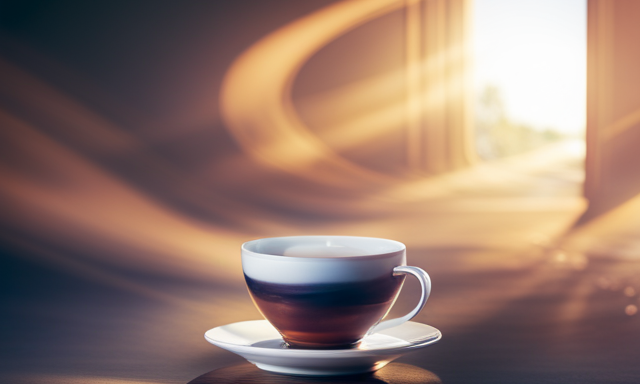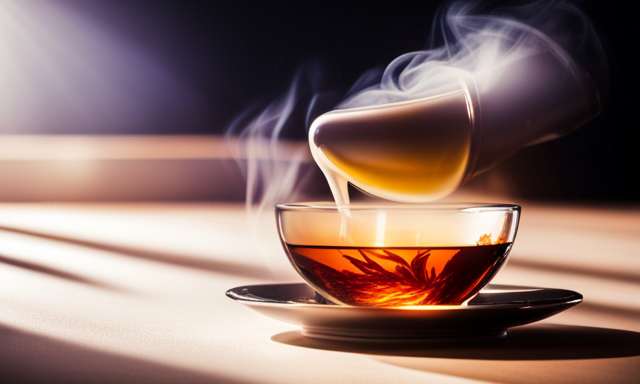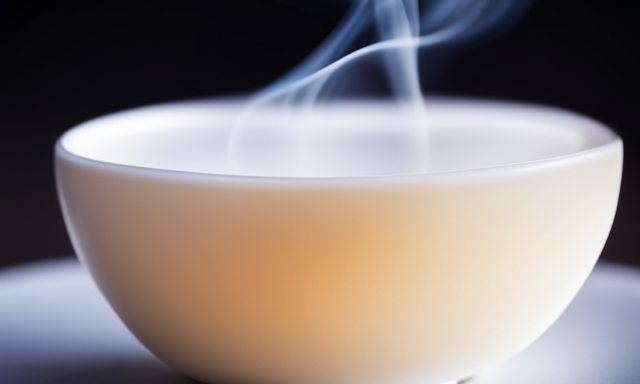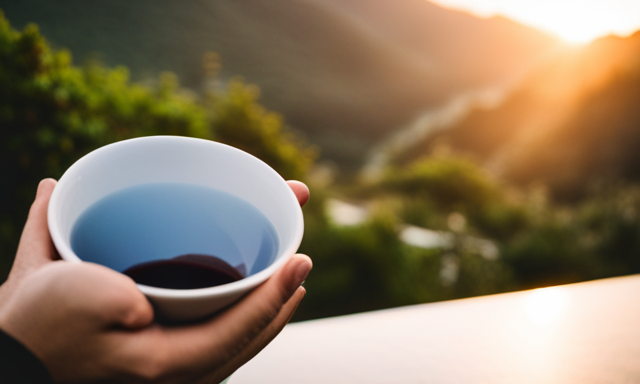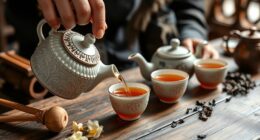As someone who loves tea, I’ve always been fascinated by the wide range of tea types and their special characteristics. One tea that has particularly impressed me is oolong tea. Renowned for its bold flavor and multitude of health benefits, oolong tea is a true standout in the realm of drinks.
Originating from China, oolong tea undergoes a meticulous production process that involves withering, oxidation, and firing. This intricate process gives oolong tea its distinct flavor profile, ranging from fruity and floral to earthy and nutty.
But what sets oolong tea apart is its potential health benefits. Packed with antioxidants, oolong tea has been linked to improved heart health and mental well-being. Additionally, its moderate caffeine content provides a gentle energy boost without the jitters often associated with other caffeinated beverages.
In this article, we will explore the origins, production process, flavor profile, and health benefits of oolong tea. So sit back, relax, and join me on this journey to discover just how good oolong tea truly is.
Key Takeaways
- Oolong tea improves cardiovascular function, lowers cholesterol levels, reduces blood pressure, and aids in weight loss.
- Oolong tea enhances mental clarity, reduces anxiety, induces relaxation, and improves cognitive function.
- Brewing oolong tea requires specific water temperature, steeping time, and tea-to-water ratio for the best flavor.
- Oolong tea has a delightful taste, aids in weight loss, is packed with antioxidants, and offers a range of health benefits.
Origins of Oolong Tea
You might be surprised to learn about the rich and fascinating origins of oolong tea. The history of oolong tea dates back to ancient China, where it was first cultivated in the Fujian province. The exact origins of oolong tea are shrouded in mystery, but legend has it that it was discovered by a tea farmer who accidentally left his tea leaves to dry in the sun. When he returned, he found that the leaves had partially oxidized, resulting in a unique flavor and aroma.
This accidental discovery led to the development of oolong tea as we know it today. The history of oolong tea is intertwined with Chinese culture and has been enjoyed for centuries.
Now, let’s delve into the production process of oolong tea.
Production Process of Oolong Tea
The intricate process of producing oolong involves withering the leaves under the sun, allowing them to oxidize, and then gently rolling and drying them to create a unique and flavorful beverage.
Production techniques play a crucial role in determining the final quality of oolong tea. Skilled tea artisans carefully control the level of oxidation, which can range from partially oxidized to heavily oxidized, to achieve the desired flavor profile. The leaves are spread out and left to wither under the sun for a specific duration, allowing the natural enzymes in the leaves to interact with oxygen. This process helps to develop the distinct flavors and aromas characteristic of oolong tea.
After withering, the leaves are gently rolled, which further breaks down the cell walls and releases more flavors. Finally, they are dried to preserve the tea’s unique characteristics.
Transitioning to the subsequent section about the flavor profile of oolong tea, these production techniques contribute to the rich and complex taste that oolong enthusiasts savor.
Flavor Profile of Oolong Tea
Indulge in the tantalizing dance of flavors that oolong tea performs on your taste buds. Oolong tea is renowned for its exquisite flavor profile, which combines the best qualities of both green and black teas. With its delicate aroma and unique taste, oolong tea offers a truly remarkable sensory experience. The flavor of oolong tea can vary depending on factors such as the oxidation level, the region it is grown in, and the processing techniques used. Generally, oolong tea exhibits a complex and balanced taste, with notes of floral, fruity, and nutty flavors. It has a pleasant sweetness and a smooth, silky texture that lingers on the palate. Oolong tea is also known for its potential weight loss benefits. It contains catechins and caffeine, which may help boost metabolism and aid in fat burning. Transitioning into the subsequent section about the health benefits of oolong tea, it is fascinating to explore how this incredible beverage can positively impact our well-being.
Health Benefits of Oolong Tea
Immerse yourself in the world of wellness as we uncover the myriad of health benefits that oolong tea has to offer.
Oolong tea has long been praised for its potential in aiding weight loss. It contains polyphenols, which can help boost metabolism and increase fat burning.
Additionally, oolong tea has been found to help regulate blood sugar levels, preventing energy crashes and reducing cravings for sugary snacks.
Another impressive benefit of oolong tea is its impact on skin health. The antioxidants in oolong tea can help fight free radicals and promote a youthful complexion. They also have anti-inflammatory properties that can soothe skin irritations.
With its potential to aid weight loss and improve skin health, oolong tea is truly a powerhouse in the world of wellness.
Moving on to the next section, let’s explore the caffeine content in oolong tea.
Caffeine Content in Oolong Tea
When it comes to caffeine content, oolong tea has moderate levels compared to other teas. This means that it can provide a gentle energy boost without the jitters or crashes associated with higher caffeine beverages.
Oolong tea can help increase alertness and improve focus, making it a great choice for those looking for a natural way to stay energized throughout the day.
Moderate caffeine levels compared to other teas
Oolong tea has a moderate amount of caffeine, making it a suitable choice for those who want a balanced energy boost without feeling overwhelmed. Compared to other teas, oolong tea falls in the middle range of caffeine levels.
It contains less caffeine than black tea but more than green tea. This moderate caffeine content allows oolong tea to provide a gentle and sustained energy lift without the jittery side effects associated with high caffeine intake.
Additionally, oolong tea offers numerous health benefits. It’s rich in antioxidants, which help fight free radicals and reduce the risk of chronic diseases. Oolong tea has also been linked to weight management and improved cardiovascular health.
With its moderate caffeine levels and various health benefits, oolong tea is a great choice for those seeking a natural energy boost.
Moving on to its effects on energy and alertness…
Effects on energy and alertness
To experience a heightened sense of energy and alertness, you may find that incorporating oolong tea into your daily routine can be quite beneficial. Oolong tea contains natural compounds that’ve been shown to positively affect mood and cognitive function. The combination of moderate caffeine levels and other bioactive compounds in oolong tea can help promote mental clarity and focus, making it an excellent choice for those needing a midday pick-me-up or a boost before a workout.
Additionally, oolong tea has been found to enhance alertness without the jitters or crash commonly associated with coffee or energy drinks. So, if you’re looking for a natural way to improve your energy levels and stay mentally sharp throughout the day, oolong tea may be just what you need.
Moving on to oolong tea and digestive health…
Oolong Tea and Digestive Health
Imagine yourself sipping on a cup of oolong tea, feeling as calm and settled as a gentle breeze on a sunny day, while it supports your digestive health. Oolong tea has been associated with various health benefits, including aiding in weight loss and promoting gut health. The polyphenols found in oolong tea have been shown to increase metabolism and help with weight management. Additionally, these polyphenols have been found to promote the growth of beneficial bacteria in the gut, improving overall digestive health.
By sipping on oolong tea regularly, you can not only enjoy its delightful taste but also support your digestive system.
As we transition into the next topic about oolong tea and heart health, let’s explore how this amazing tea can benefit our cardiovascular well-being.
Oolong Tea and Heart Health
Oolong tea has been shown to have a positive impact on heart health in several ways. It has been found to lower cholesterol levels, which is important for maintaining a healthy cardiovascular system. Additionally, oolong tea has been found to improve cardiovascular function, helping to promote a healthy heart. Overall, incorporating oolong tea into your daily routine can be a beneficial choice for supporting heart health.
Lowers cholesterol levels
You’ll be amazed at how oolong tea can help you lower your cholesterol levels. This incredible tea not only has the power to reduce blood pressure and aid in weight management, but it also has a positive impact on your cholesterol levels. Oolong tea contains antioxidants called catechins, which have been shown to lower LDL cholesterol levels, also known as the "bad" cholesterol. These catechins work by inhibiting the absorption of cholesterol in the intestines, preventing it from entering the bloodstream. To give you a clearer picture of the benefits, take a look at the table below:
| Oolong Tea Benefits | |
|---|---|
| Lowers Cholesterol | Yes |
| Reduces Blood Pressure | Yes |
| Aids in Weight Loss | Yes |
| Improves Heart Health | Yes |
With all these remarkable benefits, it’s no wonder that oolong tea is known for improving cardiovascular function.
Improves cardiovascular function
By incorporating oolong tea into your daily routine, you can experience improved cardiovascular function and reap the benefits of a healthier heart. Oolong tea is known for its ability to improve blood circulation, helping to ensure that oxygen and nutrients are efficiently delivered throughout the body.
This enhanced circulation can lead to a reduced risk of heart disease by preventing the buildup of plaque in the arteries and promoting overall heart health. Oolong tea contains antioxidants that can help protect the heart from damage caused by free radicals, further contributing to its cardiovascular benefits.
As you move forward in exploring the wonders of oolong tea, it’s important to note that its positive effects extend beyond physical health. Transitioning into the subsequent section about oolong tea and mental well-being, let’s delve into its impact on our state of mind.
Oolong Tea and Mental Well-being
Immerse yourself in the soothing aroma and delicate flavor of oolong tea, as it gently uplifts your mood and promotes a sense of calmness and mental well-being.
Oolong tea is renowned for its ability to enhance mental clarity and provide stress relief. The combination of polyphenols and L-theanine in oolong tea works synergistically to improve cognitive function and reduce anxiety. The polyphenols act as antioxidants, protecting the brain from oxidative stress, while L-theanine increases the production of alpha waves in the brain, inducing a state of relaxation.
This unique blend of compounds helps to alleviate stress, improve focus, and enhance overall mental well-being. So, brew a cup of oolong tea using the right techniques to fully experience its soothing effects and continue your journey towards better health and happiness.
Brewing Techniques for Oolong Tea
When it comes to brewing oolong tea, there are a few key points to keep in mind. First, the water temperature and steeping time are crucial in bringing out the best flavors. I recommend using water that’s around 185-205°F and steeping the tea for 3-5 minutes for a perfect balance.
Additionally, the tea-to-water ratio is important for achieving the desired strength. I suggest using 1 teaspoon of tea leaves for every 8 ounces of water.
Lastly, using the right teaware can enhance the brewing experience. Opt for a Yixing clay teapot or a gaiwan to fully appreciate the complex flavors and aromas of oolong tea.
Water temperature and steeping time
Steeping oolong tea enhances its flavor and aroma, like a warm embrace on a chilly day. The water temperature and steeping time play crucial roles in achieving the perfect cup.
For oolong tea, using water around 190-200°F is ideal. Water quality is also important; using filtered or spring water ensures that impurities won’t interfere with the delicate flavors of the tea.
Steeping time varies depending on the type of oolong tea, but generally, 3-5 minutes is a good starting point. Longer steeping times can result in a stronger, more robust flavor, while shorter times can yield a lighter, more delicate taste.
If you prefer a cold brew, simply steep the tea leaves in cold water for several hours to enjoy a refreshing and subtly sweet infusion.
As we move on to the next section about tea-to-water ratio and teaware recommendations, it’s important to remember that the perfect cup of oolong tea is a delightful balance of technique and personal preference.
Tea-to-water ratio and teaware recommendations
Now that we know about the importance of water temperature and steeping time, let’s move on to another crucial aspect of brewing oolong tea: the tea-to-water ratio and teaware recommendations.
Finding the right balance between tea leaves and water is essential to achieve the perfect flavor and aroma in your cup of oolong tea. Generally, a teaspoon of oolong tea leaves per 8 ounces of water is recommended, but you can adjust this ratio based on your personal preference.
As for teaware, there are various options available, including porcelain teapots, glass teapots, and clay teapots. Each type of teapot has its own unique characteristics that can enhance the brewing process.
Porcelain teapots are versatile and suitable for most oolong teas, while glass teapots allow you to appreciate the tea leaves unfurling. Clay teapots, such as Yixing teapots, are favored by many oolong tea enthusiasts for their ability to absorb and retain the tea’s flavors over time.
Now that we have explored the tea brewing methods and types of teapots, let’s move on to the conclusion: the verdict on oolong tea.
Conclusion: The Verdict on Oolong Tea
Overall, you’ll be pleasantly surprised by the delightful taste and numerous health benefits of oolong tea. Oolong tea offers a unique and satisfying flavor profile that’s both floral and slightly nutty, making it a truly enjoyable beverage.
But its benefits extend beyond taste alone. Here’s the verdict on oolong tea:
-
Weight loss: Oolong tea has been praised for its ability to aid in weight loss. It contains polyphenols that help boost metabolism and increase fat oxidation, making it a great addition to a balanced diet and exercise routine.
-
Antioxidant powerhouse: Oolong tea is packed with antioxidants that help combat free radicals in the body, protecting against cell damage and reducing the risk of chronic diseases.
-
Heart health: Research suggests that oolong tea may help lower cholesterol levels and reduce the risk of heart disease.
-
Mental alertness: The moderate caffeine content in oolong tea can provide a gentle energy boost and enhance focus without the jitters often associated with coffee.
In conclusion, oolong tea not only satisfies your taste buds but also offers a range of health benefits, including potential weight loss support. So why not indulge in a cup of this delightful and beneficial brew?
Frequently Asked Questions
Can oolong tea help with weight loss?
Sure, oolong tea is like a magical elixir that promises weight loss. Its benefits include boosting metabolism and aiding in fat burning. So, grab a cup and watch those pounds melt away!
What is the ideal temperature for brewing oolong tea?
The ideal temperature for brewing oolong tea is around 195-205°F. This allows the leaves to fully unfurl and release their flavors. Brew for 2-4 minutes to achieve a balanced and aromatic cup of tea.
How long should oolong tea be steeped for optimal flavor?
For optimal flavor, steeping techniques vary depending on the variety of oolong tea. Generally, lighter oolongs are steeped for 2-4 minutes, while darker oolongs may require 5-7 minutes. Experimentation is key to finding your perfect steeping time.
Is oolong tea suitable for people with caffeine sensitivity?
Oolong tea is a great choice for people with caffeine sensitivity. It offers numerous benefits like improving digestion and promoting weight loss. Compared to green tea, oolong has a richer flavor and is less bitter.
Can oolong tea be consumed during pregnancy or breastfeeding?
During pregnancy or breastfeeding, it’s important to consider safety. Oolong tea contains caffeine, so it should be consumed in moderation. However, it also offers potential benefits like antioxidants and may support digestion and weight management.
Conclusion
After exploring the rich origins, intricate production process, and unique flavor profile of oolong tea, it’s safe to say that this beverage is truly a hidden gem.
Not only does it offer a delightful taste experience, but it also provides numerous health benefits, from improving heart health to enhancing mental well-being.
So, the next time you crave a cup of tea, remember the allure of oolong. It’s like a secret garden waiting to be discovered, offering a world of flavor and wellness in every sip.

